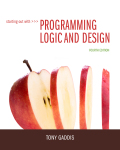
Concept explainers
A recursive function can call itself.
Hence, the correct answer is option “C”.
Explanation of Solution
Recursion:
Recursion is a process where function is called again and again by itself for a specific number of times.
- There are two types of recursive functions. They are:
- Direct recursion
- Indirect recursion
Direct Recursion:
When a function calls the same function repeatedly until the condition becomes false then it is called as direct recursion.
Indirect Recursion:
When a function calls another function which in turn calls the same calling function then it is called as indirect recursion.
Example:
Consider the following example, the function “Add()” can be called itself in the same function definition. So, it comes under direct recursion.
#Define the Add()function
def Add()
#Print the message
print('Example of recursive function!!')
#Call the Add() function recursively
Add()
Explanation for wrong options:
Calls a different module:
A recursive function cannot call the different function.
Hence, the option “A” is wrong.
Abnormally halts the
A recursive function cannot halt the program.
Hence, the option “B” is wrong.
Can be called only once:
A recursive function can call more than once in a program.
Hence, the option “D” is wrong.
Want to see more full solutions like this?
Chapter 13 Solutions
EBK STARTING OUT WITH PROGRAMMING LOGIC
- When all the statements are executed before calling the function, the calling comes at the end of code lines, this called: O a. Head recursion O b. Endless recursion Recursive call O d. Tail recursionarrow_forwardA recursive function typically has two components: one that provides a means for the recursion to terminate by testing for a(n)____________ case, and one that expresses the problem as a recursive call for a slightly simpler problem than the original call.arrow_forward2. Sum: a recursive function that computes the sum of integers 1, 2, 3, …., n for a given number n. So Sum(6) should return 1 + 2 + 3 + 4 + 5 + 6 , i.e. 21.sum(n) = n + sum(n-1)arrow_forward
- Problem Statement for Recursive Sum of Numbers Program Here is a simple recursive problem: Design a function that accepts a positive integer >= 1 and returns the sum of all the integers from 1 up to the number passed as an argument. For example, if 10 is passed as an argument, the function will return 55. Use recursion to calculate the sum. Write a second function which asks the user for the integer and displays the result of calling the function. Part 1. Understand the Problem To design a recursive function, you need to determine at least one base case (the base case returns a solution) and a general case (the general case calls the function again but passes a smaller version of the data as a parameter). To make this problem recursive think about it like this: If the integer is 1, the function will return 1. If the integer is 2, the function will return 1 + 2 = 3. If the integer is 3, the function will return 1 + 2 + 3 = 6. . . . For this problem, we will be sending in the "last"…arrow_forwardIn a recursive solution, the _____ case is easily calculated, provides a stopping criterion, and prevents infinite loops. In the _____ case, the solution calls itself.arrow_forwardRecursive Multiplication Design a recursive function that accepts two arguments into the parameters x and y. The function should return the value of x times y. Remember, multiplication can be performed as repeated addition as follows: 7×4=4+4+4+4+4+4+4(To keep the function simple, assume that x and y will always hold positive nonzero integers.) IN Q BASIC LANGUAGEarrow_forward
- JAVA CODE PLEASE Recursive Functions Practice l by CodeChum Admin Create a recursive function named fun that prints the even numbers from 1 to 20 separated by a space in one line. In the main function, call the fun function. An initial code is provided for you. Just fill in the blanks. Output 2·4·6·8·10·12·14·16·18·20arrow_forward7. Recursive Power Method In Python, design a function that uses recursion to raise a number to a power. The function should accept two arguments: the number to be raised, and the exponent. Assume the exponent is a nonnegative integer.arrow_forwardA recursive function must have a to end the recursion. recursive call base case O value boolean conditionarrow_forward
- JAVA CODE PLEASE Recursive Functions Quiz by CodeChum Admin Create a recursive function named sequence that accepts an integer n. This function prints the first n numbers of the Fibonacci Sequence separated by a space in one line Fibonacci Sequence is a series of numbers in which each number is the sum of the two preceding numbers. In the main function, write a program that accepts an integer input. Call the sequence function by passing the inputted integer. Input 1. One line containing an integer Output Enter·a·number:·5 0·1·1·2·3arrow_forwardon c++ these to q are related to each Question 01: Write a recursive function that converts a decimal number into a binary number as a string. The function header is: string decimalToBinary(int value) Write a test program that prompts the user to enter a decimal number and displays its binary equivalent. Question 02: Write a recursive function that parses a binary number as a string into a decimal integer. The function header is: int binaryToDecimal(const string& binaryString) Write a test program that prompts the user to enter a binary string and displays its decimal equivalent.arrow_forward3. Recursive Lines Write a recursive function that accepts an integer argument, n. The function should display n lines of asterisks on the screen, with the first line showing 1 asterisk, the second line showing 2 asterisks, up to the nth line which shows n asterisks.arrow_forward
- Programming Logic & Design ComprehensiveComputer ScienceISBN:9781337669405Author:FARRELLPublisher:Cengage
 C++ Programming: From Problem Analysis to Program...Computer ScienceISBN:9781337102087Author:D. S. MalikPublisher:Cengage Learning
C++ Programming: From Problem Analysis to Program...Computer ScienceISBN:9781337102087Author:D. S. MalikPublisher:Cengage Learning

